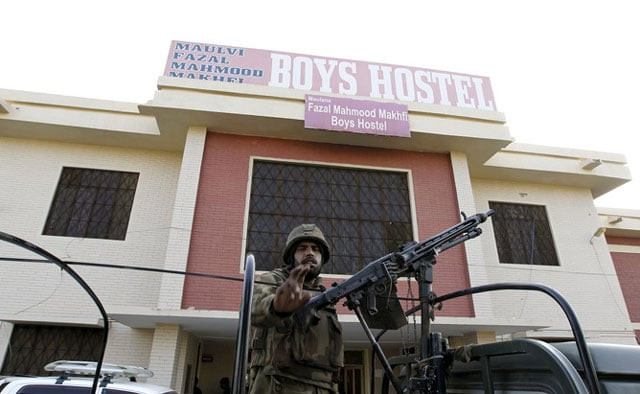The HRCP report
4,600 Pakistanis died in violent incidents in 2015, says HRCP

An Army soldier stands guard at the entrance to a dormitory at the Bacha Khan University in Charsadda, Khyber-Pakhtunkhwa. PHOTO: REUTERS
Slightly better news comes from the sectarian front with only 58 incidents and no reported sectarian ‘clashes’ though some might see this as open to question at the very least. Hundreds died or were injured in faith-related incidents, again a shameful statistic. Police encounters — a polite euphemism for extra-judicial killings — saw 2,108 men and seven women killed in 2015. There were 939 women who were victims of sexual violence — almost certainly a significant under-reporting and a risibly low number of 279 cases reported of domestic violence. ‘Honour crimes’ — 987 cases and the tip of the iceberg. Children had a bad year as well with 3,768 cases reported. Paradoxically, any rise in the number of incidents of child abuse represents an improvement as what is known as a ‘climate of disclosure’ develops and children are more confident that their report of being abused is going to be taken seriously by whoever they report it to. Child abuse, particularly sexual abuse, is emerging from the shadows with the numbers abused almost equally split between boys and girls aged 11-14. Slightly surprisingly, Sindh recorded a 42 per cent reduction in the murder rate but crime in general rose in both Balochistan and Khyber-Pakhtunkhwa while Punjab saw a small overall reduction.
Let us avoid the trap of false equivalencies and own the reality — Pakistan is a violent country in every respect, be it confined to hearth and home or death at the hands of terrorists. Some parts of the country are more prone to suffer extremes of violence than others but again the reality is that, as evidenced by the horrors of the Lahore bombing on March 27, anybody, children included, can be in the wrong place at the wrong time. Violent death is a thread within the national narrative and responses to it — the Lahore bombing is ancient history as far as the media are concerned a week later — suggest that it produces a response of learned inability to react other than fleetingly and stereotypically. When there is a robust response to a violent act as with the military taking unilateral action in Punjab post-Lahore, there are those who move swiftly in order to preserve the status quo and specifically vote banks.
There will be those who seize on the HRCP report and quote selectively from it to support a positive interpretation of the violence-curve nationally, and it would be a falsehood. The drop in incidence and incidents is likely linked to ongoing operations primarily by the military and paramilitary forces, which are doing the job that the police forces everywhere have signally failed to do. We await the 2016 figures with some trepidation.
Published in The Express Tribune, April 3rd, 2016.
Like Opinion & Editorial on Facebook, follow @ETOpEd on Twitter to receive all updates on all our daily pieces.














COMMENTS
Comments are moderated and generally will be posted if they are on-topic and not abusive.
For more information, please see our Comments FAQ